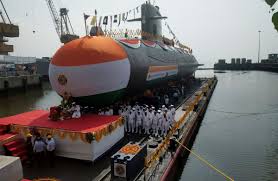
Second Ballisitic missile Subamrine

Today in Visakhapatnam, India, the second nuclear submarine of the Indian Navy, the INS Arighaat, was commissioned. The Indian Ministry of Defense released a statement today stating that the Arihant-class submarine will be a game-changer for national security, bolster India’s nuclear triad, increase nuclear deterrence, contribute to regional stability, and help establish strategic balance.
Defense Minister Rajnath Singh would commission India’s second nuclear-powered ballistic missile submarine. Many view India’s recent commissioning of the INS Arighat as an opportunity to strengthen the country’s nuclear deterrent and naval might.
In Short
- The Indian Navy has commissioned INS Arighat, their second nuclear-powered ballistic submarine.
- The K-15 ballistic missiles, which have a range of 750 mks, are anticipated to be equipped with INS Arighat.
- The nuclear triad of India is being strengthened.
Rajnath Singh praised their efforts
According to the Defense Ministry, INS Arighaat’s construction required top-notch craftsmanship, intricate engineering, specialized materials, extensive research and development, and cutting-edge manufacturing and design technologies.
According to the statement, Indian scientists, industry professionals, and navy officers conceptualized, built, constructed, and integrated the systems and equipment that make up the country’s nuclear submarine.
Superior to its forerunner, Arihant, the new submarine is the result of indigenous technological achievements. According to the Defense Ministry, the deployment of INS Arihant and INS Arighaat will strengthen India’s defenses and make the country more resilient to threats.
The Indian Navy, the industry, and the Defense Research and Development Organisation (DRDO) all worked together to achieve this capability, and Rajnath Singh praised their efforts. He referred to this degree of independence as the basis of “self-power.”. This project greatly benefited the country’s industry, particularly micro, small, and medium firms, and resulted in the creation of jobs.
“India is making great strides toward becoming a developed nation right now. The Defense Minister emphasized the importance of swift development across all domains, including defense, particularly given the current geopolitical climate.
We require a robust military in addition to a prosperous economy. Mr. Singh recalled the political determination of former Prime Minister Atal Bihari Vajpayee, who elevated India to the status of a nuclear weapon state, and stated that the current government is working feverishly to guarantee that the Indian military has access to high-quality weapons and platforms manufactured within the country.
The Indian Navy’s weaponry is scheduled to be bolstered with the addition of 750-kilometer-range K-15 ballistic missiles to INS Arighat. Ever since its launch in 2017, the submarine has been meticulously constructed and tested at the Ship Building Centre (SBC) in Visakhapatnam.
As a result, India’s nuclear triad is getting even stronger, and the country can more confidently assert its second-strike capabilities. The second Ship, Submersible, ballistic Nuclear submarine (INS Arighat) is a significant achievement in India’s nuclear submarine program.
The INS Arihant was the first SSBN in India; Arighat is the country’s second.
Four aspects regarding INS Arighat are important for you to know.
1. INS Arihant is Not as Advanced
The induction ceremony for the first submarine of its class, INS Arihant, took place in August 2016. The second submarine will likely have several upgrades and advanced equipment compared to Arihant, given the eight-year interval before inducting it.
This first-generation design, INS Arihant, was merely a technology demonstrator (TD). Even though Arighat will look a lot like Arihant from the outside, it will have a lot better internal design thanks to all the lessons learnt from running Arihant.
2. The Importance of India’s Deterrent Strategy
Arighat will strengthen India’s nuclear deterrent posture, while INS Arihant has completed the country’s nuclear triad.
A nuclear trio consists of the three distinct means of launching ballistic missiles armed with live nuclear warheads: land, air, and sea.
To bolster the legitimacy of its second-strike capabilities, considering the country’s no-first-use (NFU) philosophy, Arighat will allow India to theoretically keep a submarine patrolling its waters at all times, prepared to unleash a nuclear strike at a moment’s notice.
India runs the danger of having its land and air nuclear assets destroyed in the event of an unexpected enemy strike due to its no-first-use policy, which states that the country will never launch a nuclear attack unless provoked.
Thus, India’s deterrent posture is enhanced since a second patrolling submarine can still perform a retaliatory second strike—even if one submarine is destroyed by an unexpected attack while parked at a port or sea.
3. Indo-Pacific Long-Range Patrol
Once Arighat is commissioned, she will be prepared to conduct long-range patrols in the Indo-Pacific with her arsenal of 12 K-15 ballistic missiles.
As this may be the first long-range patrol by an Indian SSBN equipped with ballistic missiles, its rapid deployment upon commissioning is noteworthy. Although information regarding submarine patrols is kept under wraps, INS Arihant, which served as a technological demonstrator, is thought to have primarily patrolled the Bay of Bengal while the Indian navy forces were protecting it.
Indian Navy and Ministry of Defense officials are so sure in the submarine’s skills that they’ve announced a long-range patrol.Also, by acquiring this submarine, India has upgraded its deterrent, and its enemies should be warned that a confrontation with India might lead to catastrophic outcomes.
4. Twelve nuclear-capable ballistic missiles (K-15) or four (K-4)
Both the K-15 and the K-4 ballistic missiles, which are capable of delivering live nuclear warheads, are available for carriage on the Arighat. These submarines have the ability to attack Beijing, the capital of China, from the northernmost region of the Bay of Bengal.
The submarine can carry 18–30 torpedoes and has six 533mm torpedo tubes.



